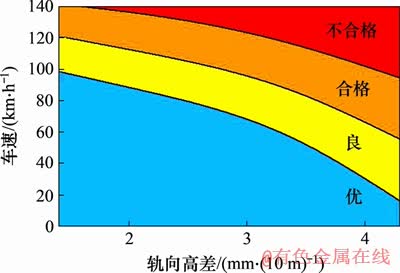由图10可知:列车行驶在线路隆起段时,垂向加速度时程曲线除自身震荡外,总体上呈现一定的波动性,前车厢垂向加速度峰值为0.058 m/s2,后车厢垂向加速度峰值为0.053 m/s2。车厢垂向振动加速度时程曲线变化趋势为:列车行驶在隆起前半段即“爬坡”段,对应时间分别为前车厢0.5~1.0 s,后车厢1.5~2.0 s,垂向加速度均值出现正向峰值;达到隆起段顶点时(前车t=1.0 s,后车t=2.0 s),垂向加速度均值降到0 m/s2左右;在行车“下坡”段(前车1~2 s、后车2~3 s),车辆垂向加速度均值呈现负值,之后稳定在0 m/s2左右震荡。

图10 车厢垂向振动加速度-时程曲线
Fig. 10 Vertical acceleration-time curves of vehicle
计算前后车行车平稳性指标分别为2.577 1与2.549 5,可见地铁列车运行在该线路隆起段时,前后两车厢平稳性指标均不达标,仅处于“良”等级,不满足规范中“优”的要求,且前车行车舒适性比后车略差。
5 行车舒适性影响因素分析
经过以上分析可知:不考虑其他荷载因素,当地铁列车行驶在基坑开挖引起的隧道线路隆起段时,列车在正常运行速率下行驶不会出现安全问题,但地铁列车大多为客车,所以,需要满足乘客乘坐的舒适性即列车运行舒适性要求。这里对隆起变形下盾构隧道内行车舒适性影响因素进行研究,着重考虑隧道隆起程度和列车行车速度2个主要因素。
5.1 隧道隆起程度
隧道隆起程度主要通过轨向高差体现。选取隧道隆起变形峰值为5,10,15和20 mm时对应的轨向高差1.4,2.1,3.4和4.3 mm/(10 m)作为隧道隆起变形量,提取隧道不同隆起变形工况下前车垂向加速度时程曲线,如图11所示。

图11 不同隆起工况下车体垂向加速度-时程曲线
Fig. 11 Vertical acceleration-time curves of vehicle in different tunnel heave cases
由图11可知:在各工况下,车体垂向振动加速度峰值分别为0.023,0.045,0.058和0.065 m/s2,可见线路钢轨轨向高差在一定程度上影响列车运行振动加速度;隆起值越大,车体垂向加速度越大。对以上4条曲线进行快速傅里叶变换,求解其平稳性指标,如图12所示。

图12 盾构隧道隆起值与平稳性指标关系
Fig. 12 Relationship between tunnel heave and stability index
从图12可见:列车平稳性指标与线路轨向高差值基本上呈线性关系;当轨向高差达到3.4 mm/(10 m)时,行车平稳性指标已经超过规范规定值2.500 0;当轨向高差达4.3 mm/(10 m)时,行车平稳性指标达到2.856 7,按照规范评级为“合格”,不满足规范规定的“优”的标准,极有可能出现乘客乘坐不舒适问题。
5.2 行车速度
分别提取36,54,72,90和108 km/h共5种车辆运行速率下后车车体的垂向振动时域曲线,并进行平稳性指标求解,结果如图13所示。

图13 列车运行速率与平稳性指标的关系
Fig. 13 Relationship between train running speed and stability index
由图13可知:平稳性指标相对于行车速率增大呈现指数增大趋势;当行车速率低于54 km/h时,列车运行平稳性指标处于规范值2.500 0以内,乘客乘行车舒适性较好;当车速达到72~90 km/h时,平稳性指标处于2.500 0~2.750 0之间,行车舒适性评级为“良”;当车速增大到108 km/h后,平稳性指标迅速增大,达到2.973 4,处于合格线边缘,此时列车运行舒适性较差,无法满足乘客乘坐的舒适性要求。
5.3 列车行车舒适性限值讨论
由以上分析可知,当地铁列车行驶在隧道隆起段时,行车平稳性指标与隧道隆起程度及列车行车速度均呈正相关关系,针对上述2个因素共20个工况下的平稳性指标数据进行二元回归分析,得到列车运行平稳性指标W与隧道隆起程度、行车速度的关系:

 (3)
(3)
式中:v为列车运行速率,km/h;Δh为盾构隧道轨向高差最大值,mm/(10 m)。由式(3)计算得到平稳性指标为2.50,2.75和3.00时的Δh-v曲线,见图14。

图14 平稳行车车速与线路轨向高差的关系
Fig. 14 Relationship between train velocity and rail altitude difference
由图14可知:当隧道轨向高差峰值达到规范规定预警值2 mm/(10 m)时,平稳行车速度约为80 km/h;当隧道轨向高差峰值达到规范控制值4 mm/(10 m)时,平稳行车速度仅为20 km/h左右,若超过此速度行驶,则会产生舒适性问题,乘客行车舒适性降低;当地铁列车平稳行车时,其车速与隧道轨向高差峰值呈现负相关关系,隧道轨向高差峰值越大,平稳行车车速越低;当盾构隧道轨向高差峰值超过3.5 mm/(10 m)时,列车平稳运行车速下降明显,此时,为了达到平稳行车要求,需对车速进行控制。
6 结论
1) 基于赫兹非线弹性接触理论,考虑车辆、轨道、隧道、围岩的空间结构特征和相互作用关系,构建了车-轨-隧一体化计算模型,建立了差异变形影响下盾构区间隧道内行车舒适性的计算方法。
2) 采用建立的计算模型,分析了隆起变形下盾构隧道内运行车辆的安全性和舒适性。当盾构隧道隆起变形不超过规范控制值且地铁列车以正常运行速度行驶时,能够保证隧道内的行车安全,但会对隧道内列车运行的舒适性产生一定影响。
3) 地铁列车以正常运行速度行驶在线路隆起段时,由车体垂向振动加速度计算得出的平稳性指标与线路轨向高差呈现线性关系,与行车速度呈指数关系;当隧道轨向高差达到规范规定预警值2 mm/(10 m)时,平稳行车速度约为80 km/h;当达到控制值4 mm/(10 m)时,满足行车舒适性要求的车速仅为20 km/h左右。
参考文献:
[1] SHI Chenghua, CAO Chengyong, LEI Mingfeng, et al.Effects of lateral unloading on the mechanical and deformation performance of shield tunnel segment joints[J]. Tunnelling and Underground Space Technology, 2016, 51(1): 175-188.
[2] LIANG Rongzhu, XIA Tangdai, HUANG Maosong, et al.Simplified analytical method for evaluating the effects of adjacent excavation on shield tunnel considering the shearing effect[J]. Computers and Geotechnics, 2017, 81(1): 167-187.
[3] HUANG Xu, SCHWEIGER H F, HUANG Hongwei. Influence of deep excavations on nearby existing tunnels[J]. International Journal of Geomechanics, 2013, 13(2): 170-180.
[4] 郑刚, 杜一鸣, 刁钰, 等. 基坑开挖引起邻近既有隧道变形的影响区研究[J]. 岩土工程学报, 2016, 38(4): 599-612.
ZHENG Gang, DU Yiming, DIAO Yu, et al. Influenced zones for deformation of existing tunnels adjacent to excavations [J]. Chinese Journal of Geotechnical Engineering, 2016, 38(4): 599-612.
[5] CHENG Y C, HSU C T. Running safety and comfort analysis of railway vehicles moving on curved tracks[J]. International Journal of Structural Stability and Dynamics, 2014, 14(4): 1450004.
[6] 张小会, 周顺华, 宫全美, 等. 路基不均匀沉降对车辆和轨道动力响应的影响[J]. 同济大学学报(自然科学版), 2015, 43(8): 1187-1193, 1253.
ZHANG Xiaohui, ZHOU Shunhua, GONG Quanmei, et al. Effect of subgrade differential settlement on dynamic response of vehicle and slab track vertical coupled system[J]. Journal of Tongji University(Natural Science), 2015, 43(8): 1187-1193, 1253.
[7] YAU J D. Response of a maglev vehicle moving on a series of guideways with differential settlement[J]. Journal of Sound and Vibration, 2009, 324(3/4/5): 816-831.
[8] RECUERO A M, ESCALONA J L. Dynamics of the coupled railway vehicle–flexible track system with irregularities using a multibody approach with moving modes[J]. Vehicle System Dynamics, 2014, 52(1): 45-67.
[9] JU S H, LEONG C C, HO Y S. Safety of maglev trains moving on bridges subject to foundation settlements and earthquakes[J]. Journal of Bridge Engineering. School of Transporation Engineering 2014, 19(1): 91-100.
[10] 杨吉忠. 考虑空气动力效应时高速列车运行安全平稳性研究[D]. 成都: 西南交通大学交通运输工程学院, 2010: 60-70.
YANG Jizhong. Aerodynamic effect on running safety and stability of high-speed train[D]. Chengdu:Southwest Jiaotong University. School of Transportation Engineering, 2010: 60-70.
[11] 高建敏, 翟婉明, 徐涌. 铁路有砟轨道下沉及高低不平顺发展预测研究[J]. 中国铁道科学, 2009, 30(6): 132-134.
GAO Jianmin, ZHAI Wanming, XU Yong. Study on the settlement of railway ballasted track and the growth forecast of track vertical profile irregularity[J]. China Railway Science, 2009, 30(6): 132-134.
[12] CHELI F, CORRADI R. On rail vehicle vibrations induced by track unevenness: Analysis of the excitation mechanism[J]. Journal of Sound and Vibration, 2011, 330(15): 3744-3765.
[13] NEJATI H R, AHMADI M, HASHEMOLHOSSEINI H. Numerical analysis of ground surface vibration induced by underground train movement[J]. Tunnelling and Underground Space Technology, 2012, 29: 1-9.
[14] GALVIN P, FRANCOIS S, SCHEVENELS M, et al. A 2.5D coupled FE-BE model for the prediction of railway induced vibrations[J]. Soil Dynamics and Earthquake Engineering, 2010, 30(12): 1500-1512.
[15] FORREST J A, HUNT H E M. Ground vibration generated by trains in underground tunnels[J]. Journal of Sound and Vibration, 2006, 294(4/5): 706-736.
[16] YANG Wenbo, CUI Ge, XU Zhaoyang, et al. An experimental study of ground-borne vibration from shield tunnels[J]. Tunnelling and Underground Space Technology, 2018, 71(1): 244-252.
[17] YANG Wenbo, LI Lingui, SHANG Yingchao, et al. An experimental study of the dynamic response of shield tunnels under long-term train loads[J]. Tunnelling and Underground Space Technology, 2018, 79(9): 67-75.
[18] XU Qingyuan, OU Xi, AU F T K, et al. Effects of track irregularities on environmental vibration caused by underground railway[J]. European Journal of Mechanics: A, 2016, 59(9): 280-293.
[19] 翟婉明. 车辆—轨道耦合动力学[M]. 北京: 科学出版社, 2015: 40-41.
ZHAI Wanming. Vehicle-track coupled dynamics[M]. Beijing: Science Press, 2015: 40-41.
[20] 艾辉军, 彭立敏, 施成华. 基于三维非连续接触模型的管片接头静动力特性分析[J]. 岩土工程学报, 2013, 35(11): 2023-2029.
AI Huijun, PENG Limin, SHI Chenghua. Static and dynamic characteristic analysis of segment joints based on three-dimensional discontinuous contact model[J]. Chinese Journal of Geotechnical Engineering, 2013, 35(11): 2023-2029.
[21] 黄强, 姚湘静, 黄宏伟, 等. 地铁运行时轨道-隧道-地层振动实测与分析[J]. 振动·测试与诊断, 2018, 38(2): 260-265, 416.
HUANG Qiang, YAO Xiangjing, HUANG Hongwei, et al. Field measurement and analysis of train-induced vibration in the whole track-tunnel-ground system[J]. Journal of Vibration, Measurement & Diagnosis, 2018, 38(2): 260-265, 416.
[22] GB/T 7928—2003. 地铁车辆通用技术条件[S].
GB/T 7928—2003. General technical specification for metro vehicles[S].
(编辑 陈灿华)
收稿日期: 2019 -08 -20; 修回日期: 2019 -11 -20
基金项目(Foundation item):国家重点研发计划项目(2017YFB1201204);国家自然科学基金资助项目(51778636);中南大学中央高校基本科研业务费专项资金资助项目(2019zzts072) (Project(2017YFB1201204) supported by the National Key R&D Program of China; Project(51778636) supported by the National Natural Science Foundation of China; Project(2019zzts072) supported by the Fundamental Research Funds for the Central Universities of Central South University)
通信作者:刘建文,博士研究生,从事隧道与地下工程研究;E-mail: jwenliu@csu.edu.cn